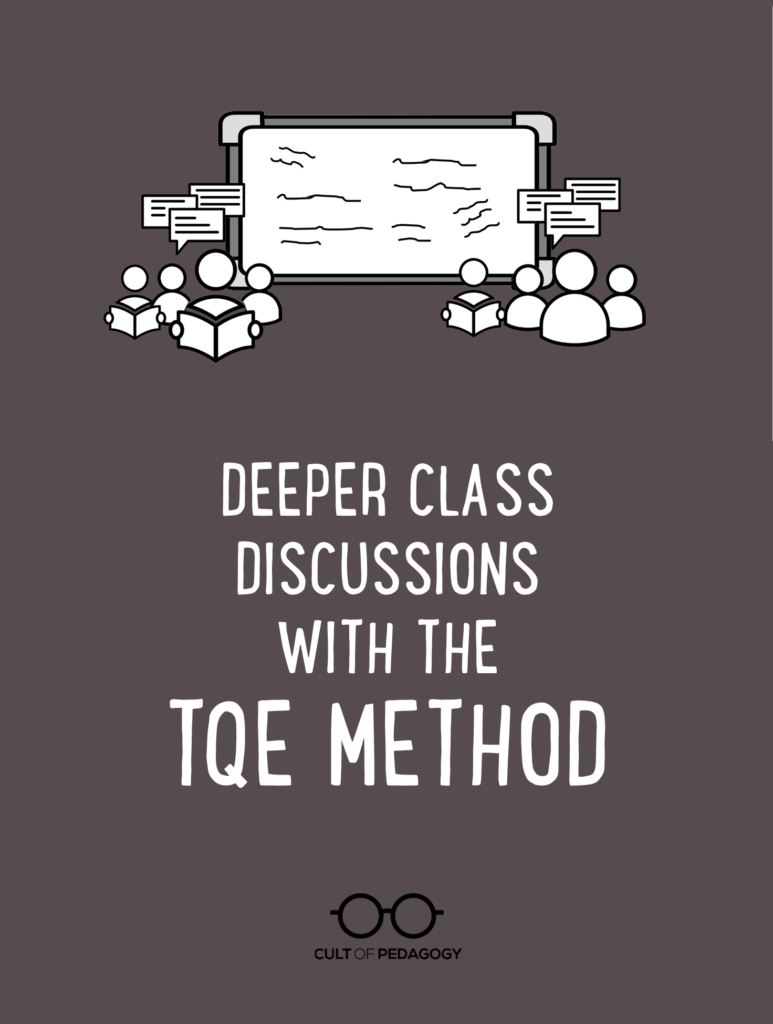
Listen to my interview with Marisa Thompson (transcript):
Sponsored by Peergrade and 3Doodler
Check out information about Marisa Thompson’s Ultimate TQE Course at the bottom of this page!
So much of the learning we do comes from texts: articles, textbooks, novels, and all kinds of online publications. Sometimes, those texts come in less traditional forms; in fact, our use of the word “text” has broadened over time to include things like films, images, and even diagrams. Regardless of what form they come in, texts make up the bulk of how our students experience learning.
But too often, when we assign texts to students, we find that they don’t experience them with much depth. One reason for that may be that we don’t set them up to do that. In many text-based classes (English, history, science), the learning cycle often consists of (1) consuming a section of the text, (2) answering teacher-created questions about the text, (3) taking a test after several sections have been completed.
For years, high school English teacher Marisa Thompson followed this same programming, and got typical results: Some students did the required work, but never seemed particularly invested in the books themselves. Others completed the questions unevenly, sometimes not answering them all, other times copying work from their peers. And when students didn’t do the work, they got calls home and office referrals.
As this pattern repeated itself year after year, Thompson became more frustrated: The texts themselves were wonderful, but students weren’t experiencing them the way they were meant to be experienced. Instead, they had shallow interactions with them, doing whatever surface work had to be done to get a grade.

Finally, she started experimenting with a different approach, and the way she teaches texts now is completely different from the way she used to. Her current approach, which she calls TQE, is similar to Socratic Seminar, where students lead a discussion on a given text, but with a few twists. Since implementing this new approach, Thompson has seen her students reading much more than they used to, and with much more depth than ever before. They are having college-level conversations about books in class, and for the first time, they seem excited about the books they’re reading.
On top of that, Thompson’s prepping and grading work for these class sessions is down to almost nothing.
What I love about this method, and why I’m sharing it here, is that I think it could be applied in a lot of different areas, not just with the study of novels. In any class where students need to read a text in order to learn, something along these lines could be implemented, and I think you’ll find that the learning in your classroom gets much richer as a result. So as you read about TQE, think about how you might be able to apply it in your content area.
The Problem
As an English teacher, Thompson found that her students were experiencing books in a very shallow, grade-focused way.
“(I would) send students home, maybe get them started on Chapter 1, and then, Hey guys, go home and read Chapter 2. Come on back and we’ll talk about it, and here’s your list of questions; you’re going to have a reading quiz. I realized I wasn’t really assessing their reading with homework and quizzes. I was assessing whether or not they did their homework questions.”
This method not only diminished the value of the books students were reading, it also led to other problems. “It made reading seem like a hassle,” Thomspon says. “I started getting a bunch of cheating. One year I had 10 kids copy off each other. It turned this amazing story—this beautiful novel that everybody should read and enjoy and love—into a discipline problem.”
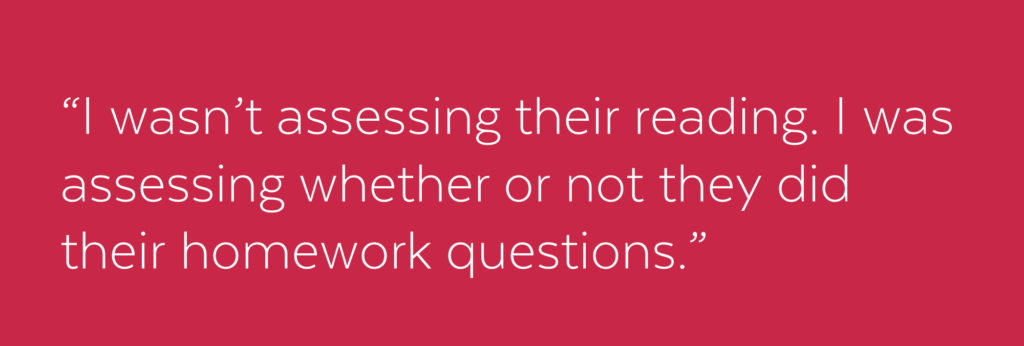
Early Changes
Knowing something had to change, Thompson decided to try grading students only on whether their participation in class indicated that they had read the book.
“I said, ‘Look. We’re going to read this book, and we’re just going to read it and talk about it. You’re not going to have study questions. You’re not going to have any reading quizzes. But I’m going to know if you read or not. I’m going to know.'”
These early discussions were similar to Socratic Seminar, where students came with questions and Thompson mostly observed. When a student participated in a way that demonstrated that he or she had read the book, their names would be crossed off of a chart. “And that was it,” Thompson says. “The standard says, Be able to read and analyze at grade level. And if they’re doing that, I mean, yeah, cross their name off. Move on.”
For students who scored low on the discussion or who weren’t initially comfortable with active participation, Thompson offered alternative means of assessment. “I said, hey, if I’m wrong with your score, then we need to come up with some sort of alternative: They were used to taking annotations, taking notes on their thoughts while they read—you can show me those. You can sit down and have a conversation just one-on-one, or you can take a test. So if you got an eight out of 10, and you’re like, ‘No, I want the 10 out of 10,’ I have a multiple-choice test on the book.”
Most of the time, Thompson’s initial score on the discussion turned out to be accurate. “I did have a lot of students who had a B for their assessment, and they’re like, No, I want the A. Great. And they took the test and then it was cute, because they were like Yeah, I didn’t really read all of it. So my assessment was, on average, about 3 or 4 percent higher than what they were normally getting on their tests.”
Right away, Thompson started to see changes in how her students were reading. “I had students who started reading more than they were assigned, and they were finishing the book early,” she says. Some were even reading ahead.
Over time, Thompson refined her approach, adding small-group time before the large-group discussions, offering scaffolding to help students develop better questions, and structuring student contributions so that the richest questions got the most discussion time.
These changes have so elevated the level of discourse that Thompson sometimes feels like she’s teaching college class. “And that’s exactly what I tell them: ‘What we just did, that was a collegiate literature course. That was amazing. You could walk into a college course and have this discussion.’ And you can see that they’re enjoying it.”
The TQE Method
Here is the approach Thompson uses now, step by step:
1. Students Complete Assigned Reading at Home
Usually, this will be a segment of a longer text, like a few chapters in a novel. Students who show up having not completed the reading are invited to finish up in the hall during small group discussion (step 2) to catch up. They are welcome to return to class for the discussion when they finish.
2. Small Group Discussions (15 minutes)
When they arrive in class, students get into small groups, where they have 15 minutes to share thoughts, lingering questions, and epiphanies (TQEs) they have about the reading. Early in the year, Thompson provides stems to help students generate these (see below), encouraging them to move from the more simplistic ideas on the left to the more complex ones on the right.
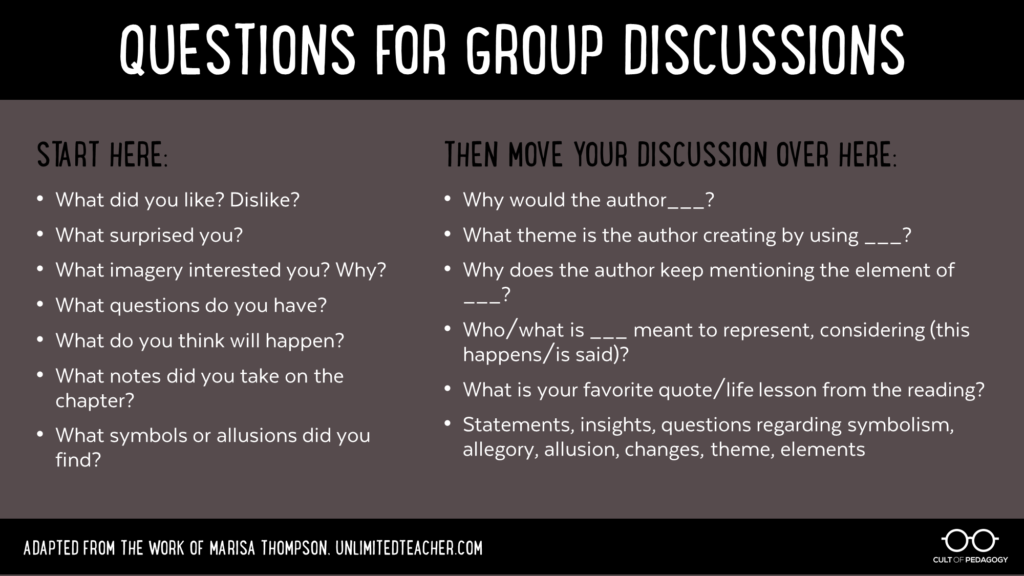
3. TQEs on the Board
By the time the 15 minutes is up, each group needs to choose their top 2 TQEs from the group and write them on the board. Although these are meant to serve as the basis for the group discussion, they are not necessarily used as is.
“If they put something on there that is not at the quality or as thought-provoking as we need it to be for the class to discuss, we’ll edit it together, the 40 of us,” Thompson explains. “So it becomes a writing lesson.”
Thompson also insists that when discussing a text, students use the author’s name. When discussing Of Mice and Men, for example, she started by having students repeat the name “Steinbeck” five times. “I love Lenny and George. I love Lenny,” she told them. “but he’s totally fictional. So when you start asking questions like, ‘Why did George do that?’ George doesn’t exist.”
Instead, she has students practice asking questions like, “Why did Steinbeck have George do that?” “What theme is Steinbeck trying to convey to the rest of us by having his character do that?”
“It’s not about the character,” she explains. “It’s not about the character’s motivation, it’s the author’s purpose in providing that motivation for the character.”
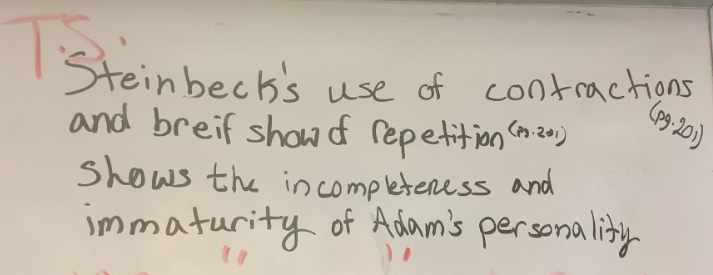
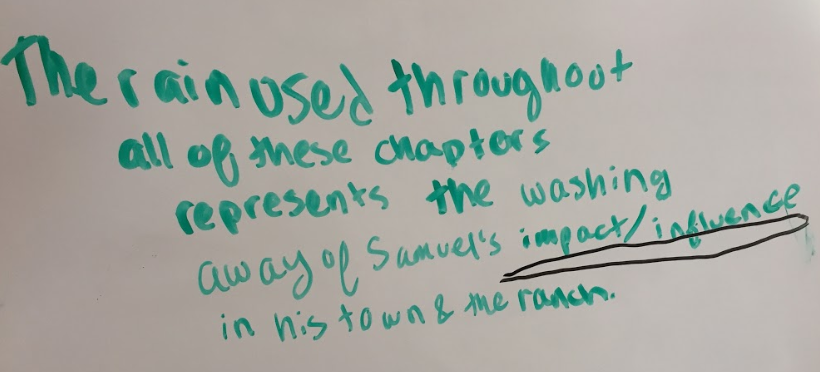
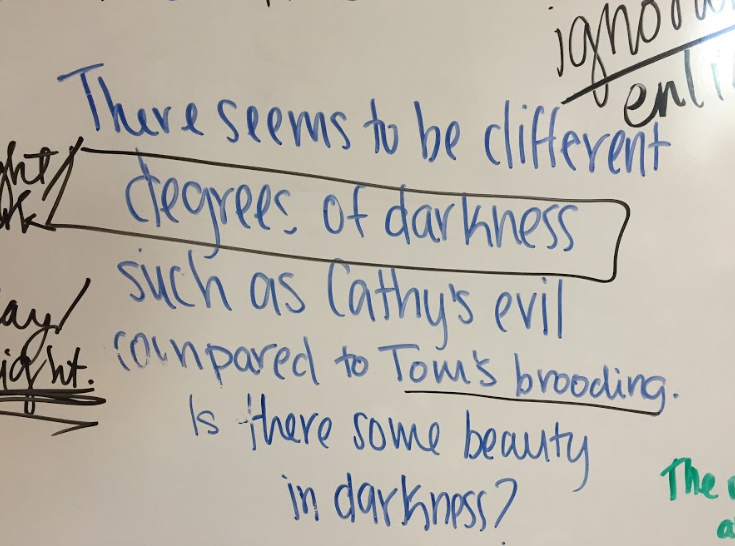
and write them on the board for the large-group discussion.
4. Class Discussion of TQEs
Thompson then moderates a whole-class discussion of the reading, using the TQEs that have been written on the board. This takes about 40 minutes of class time—she teaches on a block schedule, so there’s plenty of time to dig in. When the class is actively studying a novel, they will have these conversations in every class meeting.
As for grading, Thompson simply records when students participate, and that’s it. “I have a chart with their little pictures,” she explains, “and I cross them off as I go. So I’m not necessarily grading them every single day. My student Sally might have participated a ton one day, and skipped the next day. But my standard-based grading says she is reading and analyzing at at least grade level. I don’t need to score each of my 40 kids every single day.”
“And the amount of planning is nil,” Thompson adds. “I’m not creating, I’m not copying, I’m not collecting, I don’t need to waste my time. My prep is reading before bed every night.”
What Student-Centered Learning Looks Like
“We have all these really great aphorisms, these quotes about, ‘Students should own their learning,’ and ‘Empower students,'” Thompson observes. “And it’s like, well that’s great, but how in the heck do we do that?”
Since starting the TQE process, Thompson has seen true student-centered learning in action: Students are in charge of the content of the discussions, and the ability to participate fully has become its own motivator for completing the homework.
“The peer pressure of Everyone’s discussing this book—that becomes cool. To have an idea, to have an opinion. So the student comes in, and all of a sudden it’s, “Wait, I read that part, and I think this,” you know? And you want to talk about empowering a student? You just turned that student into a part of the classroom community.” ♦
If you are a fan of the TQE method and you want to take it further, check out Marisa’s Ultimate TQE Course. This course will revolutionize your reading and writing instruction and assessment through student-led inquiry, intentional teacher guidance, feedback that is immediately useful to students while eliminating the need for at-home grading, even for essays, and a personable approach to teaching and learning that leaves everyone in the room energized and engaged.
Cult of Pedagogy receives a portion of the Ultimate TQE Course sales that come through the link on this page.
Join my mailing list and get weekly tips, tools, and inspiration that will make your teaching more effective and fun. You’ll get access to our members-only library of free downloads, including 20 Ways to Cut Your Grading Time in Half, the e-booklet that has helped thousands of teachers save time on grading. Over 50,000 teachers have already joined—come on in.

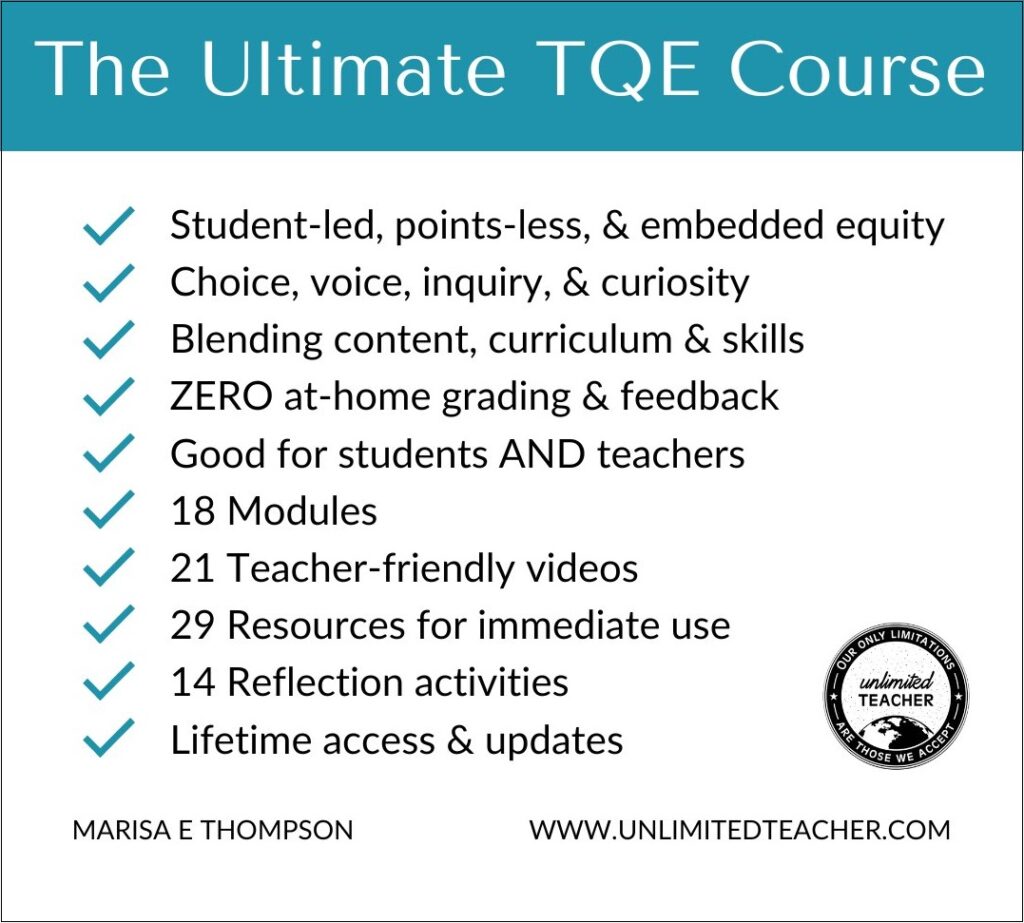




I love the manner in which TQE moves from basic level replies to more complex and higher order thinking guided by the teacher and others. I am going to adopt this in my college classroom.
Bloom would also agree with this constructive method to encourage reading and thought provoking responses!!
I’m so glad you found the TQE Process useful and I’d love to hear your results!
I think this sounds awesome! I teach 5th grade students and I have 3 classes of about 28 students each. Each class has a very wide range of abilities. Some are on a 2nd grade reading level, some at grade level, and some above. Would this work for me?
I think it works especially well for students who are below grade level. They can have success with this process because they can participate in the discussion. They can be encouraged for their contributions about connections and see the importance and relevance of reading from shared epiphanies.
I hope this helps! Please let me know how it goes!
All the best,
Marisa
I also thought this was awesome and plan to introduce it next school year to my high school yearbook class. The class also has a wide variety of abilities and might be just the thing needed to get everyone interested and working together.
I love the higher order thinking that is student centered. I agree. I am going to try this in my 12th grade math class.
I love the idea of this! Have you had an opportunity to scaffold this for students learning English and/or students receiving special education services?
This process has worked in advanced and inclusive classrooms. The “emerging leaders” I’m referring to several students with IEPs and other accommodations who thrived. The students who said they “finally felt smart?” Students who were redesignated.
It seems when we focus on the stories, their lessons, and their relevance, instead of the completion of a related homework assignment, more students feel like they can contribute.
Thank you for the question! I go into more detail and provide resources in the blog post Jennifer Gonzalez references, “https://www.unlimitedteacher.com/single-post/2018/07/10/were-killing-the-love-of-reading.” Please get in touch if you have any further questions or ideas!
@MarisaEThompson
This process has worked in advanced and inclusive classrooms. The “emerging leaders” I’m referring to several students with IEPs and other accommodations who thrived. The students who said they “finally felt smart?” Students who were redesignated.
It seems when we focus on the stories, their lessons, and their relevance, instead of the completion of a related homework assignment, more students feel like they can contribute.
Thank you for the question! I go into more detail and provide scaffolding resources in the blog post Jennifer Gonzalez references, “https://www.unlimitedteacher.com/single-post/2018/07/10/were-killing-the-love-of-reading.” Please get in touch if you have any further questions or ideas!
@MarisaEThompson
what do you do with the kids that are not interested in sharing, or don’t do the reading. This type of learning is great if all kids are invested.
It does take some time, some practice. Several students choose to participate more in the small group discussions and still others prefer to share their annotations or a chat with me instead of engaging in the larger discussions.
When we first tried the TQE process, I presented it as a great option which would keep the homework down and the grades up (since we wouldn’t have homework, reading quizzes, or a multiple choice test).
“Of course,” I told them, “it only works if you read and participate. It’s up to you. Want to try it?”
They jumped at the chance. “We can just talk about it?”
“Exactly. Like we do in college literature courses.”
I hope this helps! I go into more detail and provide resources in the blog post Jennifer Gonzalez references, “https://www.unlimitedteacher.com/single-post/2018/07/10/were-killing-the-love-of-reading.”
If nothing else, we know what the traditional gets us and it’s worth trying with one novel. I’d suggest making it the novel that’s a tried-and-true favorite to see if it works. And why not consider letting them read in class? We “get comfy” and read on the floor or sitting on desks. I even read aloud, like story time. Whatever it takes.
Thank you for the question! Please get in touch if you have any further questions or ideas!
@MarisaEThompson
Thanks for sharing TQE. I use a similar process for my online graduate courses. With the importance of the discussions paramount, I realized that when I posted the questions…it was just a typical (not so engaging) Q&A. Now I have the students team up to create the post prompts (under my guidance and for additional credit). This more resembles a class setting where the students actually ask the question and have deep, rich discussions. I have used this format for two semesters. The results are more engaged students, discussing more authentic and real-life scenarios. It has been a win-win!!
Wonderful! My favorite part about your comment is that you reflected and wanted to keep improving. That’s what it’s about!
I can relate to students who share more in small groups–this is how I started having students, in their small groups of 4-5, record their conversations using voice memo or similar app on their phones, then turning it in to me via email or Google Classroom. Then I listen on my own time and assess their learning through what I hear. I can also collect any written notes on the text and compare to what I hear. I do LOVE the idea of continuing to come back to the standard.
My question is about the nitty gritty of the grade/score. Are you using a rubric with a scare out of 10? How do you know when you’re hearing an 8, versus a 6 or a 10? Love to see a tool you recommend.
I often find rubrics limiting the learning but providing minimums, maximums, and vague descriptors.
Perhaps it is because I am used to the process and know my expectations that I do not use a delineated rubric. Or perhaps it is because the points are minimal compared to the other skills we practice and their corresponding points.
I was inspired by the Single-Point Rubric and the move to Mastery & Standards-based Grading. I read the standard associated with reading comprehension and that is an “8” for me. Go beyond this and earn a 9 or 10. Don’t quite reach it or don’t reach it consistently? This would be a 7. But I err on the side of the student if I’m not sure by asking students to provide more assessment samples: annotations, 1:1 discussion, etc. They can also take a test to prove my score needs adjusting.
I hope this helps! I think the best thing we can do for our students is whatever we know to be the best for our students. I wish I had a definitive answer!
Take care,
Marisa
Marissa, do you think that this would be easy to adapt to in a Social Studies/History classroom? With textbook & primary documents as a focus for the assigned reading?
Hi there!
I have not yet found a subject which does not work with TQE. It’s about letting students take in information, grapple with their own initial reactions, listen to peers’ thinking, curate the different views, and then discuss with a larger group to find out more.
To me, it seems to be the ultimate social studies experience!
I hope this helps! Feel free to get in touch if you’d like to discuss further!
All the best,
Marisa
unlimitedteacher.com
HI, Marisa. This was a great listen. Thank you for sharing this strategy. The only part I am unclear about is when the kids go to put their thinking on the board. Do you make columns and label them T, Q, E? Or, do they just write their responses and label them themselves? I am eager to try this out as I am moving up to 10th grade from 7th. Thank you!
Hi Becky,
Great question! There doesn’t seem to be any particular structure for sharing. Check out Marissa’s original blog post and blog – links are at the bottom of this post. There, you can find pictures of kids recording their TQEs and what it might look like in the end. Hope this helps!
Thank you Marisa and Jennifer for introducing THE to educators. I am definitely using it in my classroom on a more regular basis. I needed that boost from an expert and this was the one that will get me going. BTW, I’m a teacher in life science and health care and med focus courses and I know that this will work for my students.
Thanks again and all the best for the new academic year.
I am so happy to hear that you’re certain it’ll be successful in your class. If you have any suggestions for those teaching similar subjects, please share!
Have a great week!
Marisa
When I was finishing my MA in English 2 years ago I was interested in finding research on how to guide students on reading like writers. Listening to Marisa’s interview I thought of this. Is this what TQE is doing?
I think you will find Mike Schmoker’s 2nd edition of Focus to be of help for this. He uses Kelly Gallagher’s work a lot.
Thanks for sharing. I am going to try it in my Biology class.
I can’t to hear how this goes in Biology! If you have any tips or resources, please share for everyone’s benefit!
Stay in touch,
Marisa
This is really great. I am looking forward to trying this in my English literature class in France (high school). I was wondering how to get in touch about a collaborative project if you are interested (i don’t have Twitter :/ )
Wouldn’t it be great to do a book and TQE s with international collaboration ?
Abigail! YES! I’d love to do that! I am currently working on something along these lines with a Blog Share. Students will write and different classes from all over will read, comment, share, etc.
I’ll contact Jennifer Gonzalez to see if I can get the email you provided when leaving a comment!
Talk soon!
Marisa
Abigail (and any other teachers interested in a Blog Exchange or International TQE study of a novel),
I figured out a faster way!
If you subscribe to my website, I’ll get your email address: unlimitedteacher.com. Scroll to the bottom and enter your email!
All the best,
Marisa Thompson
I’m really excited about this and want to try it in my 4th grade class. I really want to build my kiddos into passionate readers and so i’m willing to try anything!
It will take some practice but students get used to this rather quickly!
It is also great following a quick write or as a bell assignment to review the last class’ relevance. The Grant Wiggin’s article is a wonderful resource if you’re interested in what got me reflecting.
Thanks for listening!
Marisa
Thanks for sharing Marisa and Jennifer! I love the idea of having students direct the conversation about the reading. I’m going to incorporate this strategy in my Environmental Science course.
I’m glad you heard some ideas which will work for your subject! I think this process is universal, but often teachers of the subjects will ask for samples, materials, or experience. If you can share your experience, I’d love to pass it on to others!
All the best,
Marisa
I enjoyed listening to this podcast. I am curious to hear how this might be used in a social studies classroom. Can you use it with non-fiction reading?
Hi Andrea! Somebody over on Jenn’s FB page actually asked a very similar question. Jenn shared that in social studies/history, there’s still a story that kids will have a lot of reactions to. You can also use lots of different texts that are on the same subject and see how they can compare.
I have used it for fiction, non-fiction, poetry, Socratic-style discussions and topics.
In essence, it’s information provided, your thoughts, questions, and connections/relevance.
It works for anything!
I hope you and your students enjoy the process!
Marisa
Hi,
I LOVE this!! Our middle school is required to have 2 or 3 novels going in a classroom at a time. Besides grouping the kids by novel, how might this work on a discussion level? Interested to hear what you think.
Multiple novels at a time is required… How interesting!
I think I would ask students for a list of 15+ thematic ideas and then find non-fiction, short stories, speeches, and poetry which include the same themes.
Something to keep in mind: the TQE method isn’t only for written texts but also videos, music, art, discussions. Anytime you want students to think (which sounds ridiculous), this process can work. Did they experience/observe a Socratic Seminar? Are they analyzing a political cartoon? Did a major event happen over the weekend? Is there a situation at school which needs to be examined? The TQE method will work.
An example: our first TQE experience this year was covering the topic, “The Reputation of the ‘Teenager.’”
I hope this helps! Please be in touch if you have any questions or an experience to share!
All the best,
Marisa
I wonder about adjusting this process for science, social studies, etc. Consider this after a lab. Have students go through the TQE process but with the focus on what they observed and further questions. In social studies, students could do the same after analyzing primary source documents. I love this!
What a great idea! I love it!
So many have shared how they might use this is their subject area and grade level. I’ll be putting them together this week and sharing with everyone.
Thanks for sharing!
Marisa
Thank you Marissa for sharing the TQE method and its a great strategy to make lessons more engaging and to improve learning. I know some students will prefer working alone, but as a Science teacher, I will definitely use this method to make classes more student centered, project based and collaborative.
Thanks for sharing this strategy! I love the alternative forms of participation options that you referenced in the podcast. I have a couple questions.
1. What do you do when students cannot read the text – not when it is a motivation issue, but when they literally cannot get through it on their own?
2. Did you take time to teach students how to conversate, set norms, etc. or did that take shape on its own?
I’m so happy to hear you found it useful!
These are great questions.
1. As the reading comprehension is not my ultimate goal, I am comfortable with students using the audio book, listening as I read aloud, etc. If a student still would not be able to understand the material enough to participate, I would offer alternatives to inspire thoughts, questions, and epiphanies in the topic. (That being said, I would hope the student is receiving all the support necessary to help him or her achieve grade level literacy.)
2. Yes, we do practice discussion norms and expectations with philosophical chairs and a variety of comically boring topics (Pie or cake? Beach or pool?) and some which inspire stronger emotional responses. We also thoroughly discuss the difference between discussion and debate. Our goal is greater understanding, not winning.
I hope this helps!
Take care,
Marisa
I thoroughly enjoyed your podcast. I think I heard you mention Grant Wiggins. If you did, can you please share the resource that you mentioned of his? If you didn’t, maybe Jennifer can point me in the right direction.
Thank you!
Hi Kimberly! If you scroll down to the bottom of the post you’ll find a link to Marisa’s original blog post about TQEs — it contains the link to the Grant Wiggins article I think you’re referring to: A veteran teacher turned coach shadows 2 students for 2 days – a sobering lesson learned Hope this helps!
I absolutely love this! I teach 6th grade/ 90 minute blocks, so this will be perfect. Would you happen to have a video of your class moving through the process of the TQEs and student led discussions?
Hi there!
I’m happy to hear you found the podcast useful! The video is a great idea and I will get to work on that!
All the best,
Marisa
I love this idea and plan to try it with my 6th, 7th, and 8th graders this year. Do you have any tips about timing it out for a 55 minute class period as opposed to a block?
I would suggest doing the reading the night before and allowing students to come in with prepared annotations. I would dedicate one class period a week to the TQE process. It covers a variety of skills and includes the in-depth analysis students need to be able to write something meaningful.
I hope this helps!
Marisa
I am a brand new 5th grade reading teacher, I love this idea of having the students lead the discussion. I have found that I have very high reading students who in the first few weeks have been bored with the basic, read this article together and answer the questions I ask.
I think this once we begin our novel units in a few weeks will be a great way for them to come in and discuss their thoughts on the chapters we have read. I also love the way you eliminate the character did something and instead having the students learn that it is the author who did this and not the character.
Thank you so much.
Welcome to teaching 5th grade!
This could be a solution to the problem you describe. You may also consider providing a variety of articles on the same topic which would appropriately challenge your students.
Perhaps then the groups could do their own group discussions and the epiphanies about the topic could be the class discussion! What do you think about that?
I hope this helps!
All the best,
Marisa Thompson
Thank you very much for sharing those experiences with us, teachers. They are encouraging and inspiring for my lessons.
Thank you! I am excited to share something which works so well for us. I hope teachers and students enjoy this process!
Take care,
Marisa
I tried the TQE in class yesterday. It was the first time, and I was nervous about making it work. I offered prompts for the students to think about. They came up with good sentences to share, but I had difficulty getting the entire group to discuss them. I expected a raucous exchange of ideas, but it was a few individuals doing most of the talking. How can I get more people to get excited and share?
Hi Michelle,
Thanks for the question! I can hear your disappointment, but it sounds to me like a real success for a first time. The students’ TQEs were good, it sounds like, and a few students felt comfortable to discuss the ideas. Can I ask what the “prompts” were? If it felt like study questions to the students, they may have reacted in a similar way as previous classes, but either way, this can take time.
My students have been answering question lists for years and it is a tough habit to break. Some may be concerned their ideas “aren’t right” or are waiting to see what other students do. It may also be the beginning of the year or a somewhat reserved class…? I wish I knew the answer and I wish I could’ve been there so I could give you more information!
I hope you consider trying again and letting students practice. Maybe choose an intriguing text, a TED talk, or a current hot topic? Perhaps you could tell them about this process and have them take down their TQEs as you describe it…? I bet they’d be interested in hearing about no quizzes, no novel tests, discuss with your friends, only reading for homework, etc. Let them know if [we’re] successful with this process, we can try it more long term…? It should get them talking and asking questions!
Maybe try the different variations you’re seeing tried by other teachers? There are many examples on Twitter and I’m retweeting them with #unlimitedteacher. I hope some will reply to you here, too!
I think you’re so brave to try something new and I know your students appreciate the effort!
All the best,
Marisa
I used TQE’s with my sixth grade advanced learners the last two weeks and loved it! This is my tenth year teaching “Tuck Everlasting” and I heard insights I’d never heard before.
I had the groups post their TQE’s on a Google Doc and looked for common big ideas as our daily topic. I also appointed a student to call on people so I could focus on listening, taking notes, and pushing back when needed. I also loved hearing students say, “The author did that because…” as a result of the questions. Of the students who didn’t speak much, about half are opting for the multiple-choice test and half want a one-on-one conference.
Thanks so much!
Hi Heather!
This is one of my favorite parts about TQE: This is my ____ year teaching “________” and I heard insights I’d never heard before.
So glad you and your students found it useful!
I love the twists you made to make it work for you (appointing a student, focusing on responses, looking for trends and thematic ideas in students’ thinking).
Thanks for sharing! Stay in touch and let us know other tips as you discover them!
All the best,
Marisa
I look forward to my Sunday emails from The Cult of Pedagogy. I listened to this podcast last Sunday night, and I created a TQE activity in my class (higher ed- juniors, seniors, and graduate students). I thought it worked well, and this type of activity reinforces the quotes I have seen: “telling isn’t teaching, listening isn’t learning” (original author unknown).
This activity also gives students the opportunity to practice critical thinking and learn from peers. The TQE activity helps to create opportunities for active learning versus passive consumption or just responding to my questions in-class. I thought it was simple to tailor this activity to my class content.
Hi Alexandria,
Thank you for your reflection. I appreciate the points you make and believe these skills are absolutely necessary.
It has been wonderful to see teachers of all grade levels finding success in this method! Thank you again!
All the best,
Marisa Thompson
Hi there,
I teach middle school ELA in a sub-separate (SPED) class. My classes have between 4 and 11 kids. Do you have any suggestions as to how to make TQE meaningful with such a small group?
Hi Elizabeth,
I would get the class talking… a ton. We’re in Week 3 and have discussed “The Reputation of ‘Teenagers’” and “What Matters?” They are topics every student can discuss and lead to deeper discussions: “You said family is #1, which is great, but do your actions support that?” I wander around and play Devils Advocate, I ask “why?” and stay for a bit at the tables to keep conversations going.
With such a small group, perhaps partners or triads will work well. I’d make sure to mix them up but for the more personal topics I typically keep friends together.
Intriguing topics and articles always work. I love Rick Reilly’s Half the Size, Twice the Man and there’s a fantastic TED talk called Countdown to the One Word Which Will Change Your Life by Kevin Corcoran, Jr.
You may also consider splitting the class in half and asking for 3-5 of the best things to come out of their group discussions. I typically present the TQEs from the board and start asking questions. I also sit at the same level as the students and notice participation increases.
I hope this helps! Let me know how it goes and how you tailor it to your class!
All the best,
Marisa Thompson
I teach an anthropology elective and I’m always looking for ways to structure class discussions of texts and films. I took your ideas and made my own chart of discussion starters: https://docs.google.com/document/d/10Fbr-cqbPW1HXFOcFWmRxlFWKEGRge1olTyN2CKqRA0/edit
Feel free to adapt it for your own purposes. I follow a strict TQE protocol now and find that it leads to deeper, more analytical conversations. My students are really starting to discuss texts and films at a level expected for college. Thank you!
Hi Jenny!
Thank you, first for trying something new for your students’ benefit, and second for sharing your experience and the material you created.
I’m glad you are seeing results and that your students are having collegiate style discussions. I would love to see their TQEs! Any tips for teachers wanting to try it for the first time?
If you are up for sharing some of the students’ TQEs, please tag the images with #unlimitedteacher.
Thanks again for sharing your experience!
All the best,
Marisa Thompson
I used this method with my freshmen after they read “The Necklace” and it worked really well. I’m going to try it with “Frankenstein,” but I’m going to structure it with a couple of passages from the novel that they have to base their questions on. They are passages that they might have skimmed through, and I want them to really focus on them because they’re important.
Hi David,
I think it’s really smart to start with a small piece for practice and reflection before moving into a novel.
The students will really appreciate your help in focusing their reading when necessary. “Let’s look again at this piece” always leads to intriguing discussions about the text and about reading.
Thanks for sharing your experience!
All the best,
Marisa Thompson
Do you have videos that shows this in practice?
Hi Andrea,
Not yet, but it’s in the works!
I’ll be sure to reply when it happens.
All the best,
Marisa
Thank you so much for sharing! I have down this lesson/format of discussion three times now with my 7th grade students over the past two or three weeks discussing the novel we are reading. One class spent the whole class discussion time on one question a group developed. It was amazing to see. I have added “Active Listening Notes” so if students are really uncomfortable speaking in front of the whole class or for students who do not get called on, they are still actively engaged in my class. Again, thank you so much for sharing this technique and being honest with some issues that may happen along the way. It made it so much easier to approach, knowing that it wasn’t perfect and I shouldn’t expect to be perfect either.
Hi Sarah!
I’m thrilled to hear this, as you can imagine! Yes, it is not perfect, but I love it. I’ve been fortunate to have many classes like this and I assure them this is what a college literature course is like.
I would love to know more about your Actove Listening Notes. Are they annotating the discussion? I do this with what I call Left & Right Annotations. If it’s something else, please share!
Thanks again for letting me know. I’d love to see their TQEs if you can share a picture on Twitter!
I wish you many more days like the one you described!
Marisa
Are you willing to explain and/or share what Left/Right Annotations are?
Hi there!
Yes, I recently wrote a post on annotations and hope it helps:
https://www.unlimitedteacher.com/single-post/2018/08/26/Annotate-My-Way-or-Else
Please let me know if you have any questions!
Marisa
I listened to the podcast and loved the idea, especially the ease with which I could put it into practice. I’ve used TQE a few times now in my Self-paced AP Economics classes at the Singapore American School. It has worked brilliantly. I intend to start implementing it in my Advanced Topics class on Globalization and my course on Behavioral Economics and Game Theory too. Thanks for sharing your ideas!
Hi Patrick,
That’s fantastic! I find it simple to implement, too, and am proud of my classes who are also trying it for their first time. They just requested a novel their advanced English peers are reading; its 3x in length than the one I had planned to read.
If you’re interested, I’m also piloting an International Student Blog Exchange! I wanted my students to write more and practice certain skills in low-stakes posts with high interest topics (their choice). If you’re interested: bit.ly/IntlStudentVoices. So far we’re sharing with several classrooms across the US as well as Argentina, Australia, Japan, Korea, etc.
Thanks for sharing your experience with TQE! I’d love to see their TQEs if you’re on Twitter!
All the best,
Marisa
For Patrick Hopkins/anyone else who has a TQE chart they have crafted:
Would you mind sharing the chart you may have developed for TQEs in your Economics course? I am trying to compile a stack of TQE guide-charts for students in a variety of courses (I teach English Lit), so I can bring the strategy to some colleagues.
Yes, this would be great!
When you say “chart” are you hoping for something to track students’ involvement or something to help students?
I’d love to see what is shared! I’ve been retweeting teachers’ TQE tips and twists on Twitter with the hashtag #UnlimitedTeacher.
Stay in touch and let’s see what we can find!
All the best,
Marisa
My professional background is teaching high school math, but currently I homeschool my children and teach in our homeschool co-op. I co-teach British literature to twenty-four high school students ranging in age from thirteen to seventeen. We implemented book-club-style small group discussions the first week of class and discovered this podcast the following week. My co-teacher and I were so excited because it fit right into the ideas we already were implementing. We tried it out the next week with great success. Only meeting once a week can seem to be a huge disadvantage, but these students are getting so much out of their reading and other work, thanks to the TQE method. We have been absolutely astounded and amazed by their insights and their level of engagement! Frankenstein truly came alive for our students! (Little joke there. Of course our students are now obsessed with correcting people that Frankenstein is not the creature.) We can hardly get the students to stop talking and it is astonishingly deep and on-topic. Thank you so much! I am interested to see how the discussions go on a humor piece (we are reading P.G. Wodehouse next). This next quarter, I am going to attempt to figure out how to implement this with the physics class I teach at our co-op and hope to see similar levels of engagement and depth of understanding.
Justine,
I am thrilled to hear about your experience with this method and the engagement you’re seeing. I love it and my appreciation of literature and education increases with each experience.
Many of my students read Frankenstein and after experiencing TQE they told me they “wish [they] knew what it was really about.” I told them now that they can read this way, they can always return to it.
Thank you for your willingness to try something new! I am always encouraged for our future when I hear students having robust discussions. It’s what we all need.
If you get a chance, I’d love to see some of their TQEs and know what tweaks you made for your students to make it so successful! I am on Twitter or you can get in touch through UnlimitedTeacher.com.
Take care,
Marisa Thompson
I love the structure of this activity. I’m always looking for ways to improve the discussion structure of my courses. Since I teach undergrad literature courses, most of our time in class is spent discussing what we’ve read/watched for homework. [I tend to use a lot of think-pair-share activities or small group -> large group sessions. I also have students lead their own analysis discussions/activities in groups of 3.]
For the TQE approach, I’m wondering about the third part of the strategy, where you mention the importance of having students name the author and consider the author’s purpose rather than the fictional character’s motivation. I tend to take a more reader-response approach to teaching literature, rather than an authorial-intention approach. So, when discussing a character’s actions or reactions in a scene, I might ask, “As a reader, what parts of this scene/chapter/novel overtly tells you or subtly suggests to you why [insert character] acts/reacts in this way?” After analyzing the content, diction, illustrations, paratext, etc. of the novel in our discussion, I will (usually) have my students consider if their interpretations seem to be intended by the author, mostly influenced by their own personal experiences, or a combination of both.
So, basically, I’d love to know more about your reasons for strongly emphasizing the author’s purpose in this type of activity. I tend to shy away from this topic unless I already have some research collected that includes information on the author’s intentions with a text. And with all the work I have to do as a PhD candidate, I don’t tend to prioritize author research. This post makes me wonder if I should be.
Thanks for sharing this activity design! I’m looking forward to adapting it in the future.
Hi Erika,
I’m sorry it has taken me a week or so to respond, but honestly, I’ve been thinking about your comment. So much so, I even asked a few students what they thought and what they might say in response. We were all interested and we have some thoughts to share:
First, we do discuss a little bit about the author and time period of the writing, but not much, unless it is absolutely necessary to understanding the text (The Crucible, for instance).
You state that you do move from small group to large group discussions and I assume you have found this to be effective.
In your comment, you recalled the fact that I state there is “the importance of having students name the author and consider the author’s purpose rather than the fictional character’s motivation. I tend to take a more reader-response approach to teaching literature, rather than an authorial-intention approach.” And yes, I do find it to be transformational for my readers (and so do they).
Until this point, they have focused mostly on the characters and have not yet considered that an author is the “puppet master” who chooses the characters actions, words, beliefs, etc., with a specific aim. (Thank, Darren, for “puppet master.”)
After we discussed your comment, we believe you are doing an author-focused discussion by looking at specific writing choices. We also think perhaps your students are old enough, and have read and seen enough, to know someone has created the work and has a purpose in having the characters do this and that.
You said you and your students will discuss questions, such as, ““As a reader, what parts of this scene/chapter/novel overtly tells you or subtly suggests to you why [insert character] acts/reacts in this way?” We continue those discussions by discussing the author’s purpose: “How does this support the author’s purpose/theme? What other character response would better promote the author’s theme? Would the opposite reaction disrupt the message?”
Since your discussions already connect to your students’ own lives, you’re already exploring their epiphanies, but we think perhaps those discoveries could be more universal and discuss humanity (but we aren’t there, so we assume that’s happening!).
My last thought after this week of pondering your comment is this (and forgive me if it’s too philosophical, but I do mean it): I’m trying to be more intentional about showing my students the impact they have.
Their actions, inaction, words, lack of words, are having an effect, whether they mean for them to create such an effect or not. I want them to be purposeful and intentional; to see there is a reaction to their actions (or lack of actions). They aren’t waiting for “real life” and I don’t want them to wait until a magical age before they realize their impact.
Maybe I’m hoping they’ll see the novel’s chain of events which come from a character’s choices and have the epiphany that they are their own author; that they can be intentional in creating the life they want to live. It’s our major focus for East of Eden which is coming up, happily.
I hope this answers your question. Thanks for being patient!
All the best,
Marisa
Sorry for taking so long to reply to your thoughtful response! I’m so used to getting emails when someone replies to a comment that I didn’t realize that wouldn’t happen in this case.
I love that you took the time to discuss my comment with your students. Like you, I definitely want my students to see themselves as agents in their own lives, rather than passive recipients. That’s why I tend to place reader response above authorial intent when having my students analyze our required texts. We definitely do discuss an author’s potential or actual intentions when writing the novels, but I care more about how students interpret the author’s words because they read it through the lens of their own lives.
As for talking “big picture” about humanity more generally (rather than just about the author and/or themselves), that’s definitely a major element of my courses. As most of them are general education courses for a humanities credit, thinking more broadly about how society is portrayed and/or influenced by the novels we read (and the new media we watch) is essential in all my literature courses.
Thanks again for taking the time to respond so thoroughly!
I love this! Question though…. when students write their “TQE” on the board, are they writing their question or the answer to the question? Or both? Thanks for sharing!
Hi! Great question!
In the beginning, I ask only for the questions they can’t answer in their small groups. Later, I’ll ask for the question and a guess. As students gets more comfortable with the discussions and analysis, they end up providing their answers.
That’s when things get really interesting because they offer great writing mini lessons!
I hope this helps! I’ve been retweeting tips, tricks, and images from teachers trying TQE. Let me know if you need anything!
Happy 2019,
Marisa
How would you envision this working on a normal 50 minute per period schedule in high school classrooms? I find that discussions at the 11th grade level allow us to dive deeper into texts, but days and times are limited. So many chapters a night, and so many students are able to discuss in class, that sometimes I feel I get stuck.
Thank you for sharing and thanks for your help!!
Hello!
Yes, I sure do appreciate our block periods when we’re studying a novel.
My suggestion would be to do TQE one day per week. I give my students 15 minutes for their discussion and TQE curation. The remaining 35 would be for class discussion.
Or perhaps 25 minutes could be for small group discussions and the next day could be dedicated to the whole class discussion.
It seems like a lot but considering the number of skills being practiced, how it can strengthen class culture, and how it leads to writing lessons, I think it’s worth it.
If you give it a try please know it may take a few times but I hope you find it as successful!
All the best,
Marisa
Hi Marisa,
I am always looking for ways for students to take the lead in their reading and discussion so I really appreciate this method! I second everyone in hoping that there will be a video of this in action sometime in the future!
I was wondering:
1) Do you set this up like a Socratic Seminar (with desks in a circle)? Is this basically a Socratic seminar but with the students coming up with the questions instead of the teacher?
2) Do you decide which questions students discuss first? (the order of the questions)
Thanks so much! Can’t wait to try this out!
Caroline
Dear Marisa, Dear Jennifer,
I came across your podcast about 2 years ago and stumbled on the TQE episode last year. I was thrilled right from the start: What an excellent idea to turn this whole question-thinking-answer game around and put the action and responsibility into the students’ hands.
So, today, I finally had the opportunity to try out TQE in my English class. And what can I say… goosebumps!
My year 11 AP English class here in Berlin, Germany are mostly struggling readers but the questions they had about John Green’s Looking for Alaska were the basis of a deep and sometimes quite controversial conversation. I felt they were engaged and really trying to make sense of the characters, their actions, the reason why they behaved like that, etc.
What’s more, so many questions about the first part of the book came up that we couldn’t deal with all of them in that first lesson that I think the students will now continue to read much more attentively in order to answer them. …talking about intrinsic motivation!!
I used PADLET to let the small groups share their questions, answers and thoughts. After the students posted their fist TQEs all I did was picking one to start with because they were a bit hesitant and it all went from there.
THANK YOU SO MUCH for all your inspiration!!
Katrin, thank you so much for sharing your success story. I’ll be sure to pass this on to Jenn. It’s a beautiful thing when we try new strategies out in the class and have such great results. I hope the TQE method continues to serve you and your students well!
My testimonial, as a high school ELA/SS teacher in North Idaho:
I began implementing the TQE method after I had listened to the podcast over the previous summer. I dove in headfirst, eager to try something new and engaging for students who have become dull to over-quizzing, boring chapter questions and end-of-novel comprehension tests. Over the course of this year, through To Kill a Mockingbird, Farewell to Manzanar, Into Thin Air (and various other short stories/poems) my students have begun to ACTUALLY ENJOY reading novels in class again. They love the TQE method, as it allows them to think about the novel critically in their own framework of thinking, and not in the framework I place them in.
After using TQE throughout the year and in teaching the critical year of learning and standardized testing that is sophomore year, my SBAC scores went from 69% proficient last year, to 83% proficient through the exclusive use of TQE during novel study. I did not do any “test prep” days at all – just thinking, analyzing, questioning, discussing – it all lead to student achievement when we let them think for themselves. TQE gave my students the practice they needed to become deep analyzers and discussion masters… which in turn lead to success on our standardized tests.
So… TRY TQE! Your students will appreciate it, and so will your admins when those scores come back 🙂
I love your blog, and have learned so much from so many of your posts! Recently, I have relistened to this podcast on how to get HS kids having deeper discussion about books with the TQE method. I teach AP Biology, and for our after-exam activity, am running a book club. Last year we all read The Sixth Extinction by Elizabeth Kolbert and it was awesome. In an effort to make it more awesome this year, I offered a choice from among 4 different nonfiction books with a science/environment/ecology theme. Any tips for structuring the class discussion when there are 4 different small groups reading 4 different books? Thank you!!!
Hey Jenny, I think it’s a great idea to offer students a choice of which book they’d like to read. Having groups of students reading four different books in the same class presents both challenges and opportunities. You might consider modifying the TQE method to fit your goals. For example, instead of doing the third step of having a whole class discussion, maybe you could do a different activity that allows each small group to build on what they’ve discussed. Depending on the length of your class, you could rotate around to each group to lead a more structured activity or assess how groups are doing. Another idea would be to have the small groups take turns presenting to the whole class as they go through their respective books so that all students gain familiarity with the themes and story elements or each book. It might even be interesting to facilitate an activity where small groups have to work together to compare and contrast the books they’ve read. As with any activity, it would be best to model the TQE method with students before you have them doing the work on their own, especially with adding the element of having four different books. Have fun with it!
These TQEs look like such a good idea! I’m hoping to implement these a lot this semester to get my 10th graders excited about reading again.
One practical question, though: What does “moderating” the discussion look like for you as a teacher? I’m especially thinking of the first few times I’m teaching a TQE to my class; I don’t want to control the conversation, and I also don’t want the whole class to stare at the TQEs in silence. What techniques have worked well for you in getting students started on the conversation without relying on the teacher to micromanage it? How do you practically move from Step 2 to Step 3?
Hey Jill, great question. As with any new strategy, it will probably take trying it out a few times in class before you strike a balance. I always find that modeling what you want the students to do, as well as providing them with scaffolds like the question stems listed in this post, are helpful ways to introduce something new. As students get more familiar with the process, and as you adjust to their needs, you’ll find that balance. For more discussion on Marisa’s advice for moderating the discussion, check out this comment and this comment. If you haven’t already, I’d also recommend checking out Marisa’s TQE blog post for some more tips about using this strategy in you class. Hope this helps!
What do you do if the student is absent?? How many grades do you typically take per book/reading?
Rather than simply assigning grades for work students complete, the TQE method really frees up the teacher to focus on having students engage in meaningful conversations about what they are reading. If a student doesn’t participate in the discussion one day or happens to be absent, the teacher can look for that student to contribute to the discussion on a different day. This process of monitoring student participation and progress towards meeting targeted standards is continuous, and you can do it whenever you have TQE discussions with your students.
How does this method work online? What platform is best
for dividing students in small and large groups under a teacher’s supervision?
Hi! The ultimate question for our current situation, right?
Honestly, a lot of teachers and their students have designed solutions for online learning. I highly recommend searching the hashtags #TQE and #UnlimitedTeacher on Twitter (there’s a post or two on Instagram but mostly Twitter). I’ve also shared some online learning resources that may be useful (@MarisaEThompson).
If you can’t find what you’re looking for or have more questions, please get in touch at unlimitedteacher.com!
Stay well,
Marisa
Thanks Marissa, this is excellent, I particularly like the broad hook component of the first set of questions then advancing in complexity. This has helped refine my thinking – I was heading in the right direction but not there yet! Carol Dweck : ) Kind regards, Helen
I love how approach will allow student to be more active in making personal decisions about their education.
I agree when students feel like they have some control over something they are more willing to do the work and put more effort in completing it.
Marisa,
I know I’m a little tardy to the party, but I just wanted to tell you how much I appreciated reading your methodology. I was a first year college lit teacher last semester teaching a blended course and this was EXACTLY what I wanted my students to experience. They were rock stars, especially with designing discussion questions and expressing themselves in class, but I struggled to keep the environment student-centered. It was a Socratic style of discourse which allowed the students to talk and voice their opinions, but it was almost always teacher-dominant (me asking questions, them building off each other’s analysis in discussion). I consistently found myself leading discussion, not facilitating. Your collaborative grouping is just what the doctor ordered, and I’m excited to try it out in my new high school classroom. You’re the bomb.com!
If nothing else, we know what the traditional gets us and it’s worth trying with one novel. I’d suggest making it the novel that’s a tried-and-true favorite to see if it works. And why not consider letting them read in class? We “get comfy” and read on the floor or sitting on desks. I even read aloud, like story time. Whatever it takes.
I agree so many times I hear students not understanding the their homework but their teachers are checking to see if they have completed it. At my old school one of our most outstanding “blue” teachers decided to change things up and start doing homework in class with her students so that they were able to go over the work and she was making sure they were understanding the standards.
Thank you Marissa for sharing the TQE method and its a great strategy to make lessons more engaging and to improve learning. I know some students will prefer working alone, but as a Science teacher, I will definitely use this method to make classes more student centered, project based and collaborative.
Could you please clarify the difference between a “thought” and an “epiphany” in the TQE method? Thanks!
Based on how I interpreted this strategy, I would say a thought is a simple observation or point of understanding, whereas an epiphany signals a deeper level of understanding. For example, “I like the author’s use of repetition throughout the text” is a thought, while “The repetition is a deliberate use of a literary device meant to evoke a sense of irony” is an epiphany. The idea is that through discussion, students can move from generating a series of thoughts about a text to analyzing and evaluating the text.
If you’d like to read more, I recommend clicking some of the links in the post that lead to more information and resources. Hope this helps!
Thank you for this – so helpful for inquiry-based, student-driven classroom discussions!
I’m curious about what this looks like in practice and how it differs depending on classroom dynamic/characteristics. How might this play out differently based on grade level and what adjustments might need to be made depending? What are the benefits of self-selected groups for this vs. other ways of selecting? I feel like classroom sizes keep getting bigger and bigger and I’m wondering how well this works in a classroom size of 30+ without getting too chaotic. Lastly, I’d love to get peoples’ opinions on this who use this method – how involved are you during the 15 minute small group discussions and what’s been most successful?
I came across this post from a recommendation in a Facebook group. The idea sounds great – in theory. We’re getting ready to start a novel unit, so I like the idea of having the students generate the questions. Here’s the problem – we have MAYBE enough for each of the three English 3 teachers to have a class set, so reading at home isn’t an option. How would something like this work in that situation?
Heidi, I have a few suggestions for how you could do the TQE method without having physical copies of the text for students to read at home.
If your school has 1:1 technology for students, your department may be able to look into an e-book option where students can borrow digital copies of the text to access at home on their devices.
If technology is not an option, you could restructure your class time so that part of the class is designated for reading and part is designated for the TQE discussion. If you scroll up to step 1 in The TQE Method section of this post, you’ll see that Marisa offers some in-class reading time for students who need to catch up. In a similar fashion, you could embed reading time directly into the class routine for all students.
Another option could be to facilitate a micro-version of the strategy by selecting certain excerpts of the text that you think hold particular value for engagement with the TQE method.
I hope these ideas spark your thinking! If you try any of them out, we’d love for you to come back and tell us how it went!
Hi Heidi!
First, thanks, Margaret, for your suggestions! Any ideas can really start the next one and the next one…
Heidi, I completely understand the dilemma and have a few questions – but for the sake of this response here, I’ll make an assumption or two based on my inferences from your comment. If you’d like to chat, I’ll make a suggestion at the bottom of the post!
It sounds like you and your team will teach the novel at the same time; otherwise, perhaps the novel situation wouldn’t be so tough…? If this is a constant for your team, I would think you would approach reading however you have been able to do novel studies in the past.
TQE discussions (and their Left & Right Annotations) are student-led substitutes for other types of assessment that aren’t as accurate and don’t offer student-generated skill practice (quizzes, chapter questions, etc.). The time isn’t so different than reviewing homework, administering quizzes, answering questions… it’s a different way to use that same time in a way that builds understanding and skill, fosters community, and increases interest in the reading itself. I hope that makes sense.
Many teachers have made some pretty cool shifts to fit their class needs and accommodate the occasional constraint. Some do TQE once each week. Others do the group discussion on one day and the class discussion on another. Some do the group discussion and skip the whole class discussion. It depends on the current point of the novel, the goals, the calendar, anything!
You could also do TQE for related or unrelated short texts while keeping your novel approach the same: articles, paintings (so fun!), videos, TED talks, current events, author bios and interviews, etc.
What I have found (and other teachers, too) is that once students get pretty skilled at Left & Right Annotations and TQE discussions that this type of analytical thinking becomes natural for students regardless of the information presented (the whole point!). Then parts of the process become more fluid, shorter, and less “required.” For my classes, Left & Right Annotations were only required for the beginning of a novel. Most students kept them going only because they knew it helped them understand the text and prepared them for whatever project or writing they’d be doing.
I hope this is helpful. If you’d like to chat about it, please connect with me through social media (Marisa E Thompson or the hashtag #UnlimitedTeacher) or the contact page on my site, unlimitedteacher.com (https://www.unlimitedteacher.com/bookmarisa). Then we can see how we can make this work for you, your team, and your students!
Wishing you a super successful and smooth Spring!
All the best,
Marisa Thompson
Thank you for having this forum to help with learning motivation and helping students get excited about achieving.
She does lead with motivation and gets them excited to achieve things they did not see them getting.
I love the student-centered approach. It always allows for student input.
I am curious how this works with students who work at a lower level. I could see some students just sitting and not participating because they really have no clue. It is an unfortunate side effect of our current educational system. We have taught kids how to be really good at memorizing so they can pass a test. I crave these types of conversations in my high school classroom.
Yes, so many educators crave these types of conversations in their classrooms! Fawn, you are right that an overemphasis on standardized test scores can perpetuate a culture that prioritizes fact memorization. I think this is all the more reason to provide students with opportunities to engage in rich, meaningful, and shared learning through strategies like the TQE method!
If you have not yet read the entire blog post that accompanies the podcast episode, I would encourage you to do so. Jenn outlines several of the scaffolds that Marisa Thompson has used to ensure that each student has an accessible entry point and an opportunity to show their learning. There’s even a chart about halfway through the post with questions designed to help move group discussions from simple to complex.
I’d also suggest that you take some time to read through the other comments on this post. You are not alone in wondering about this! Marisa has responded to several similar comments with ideas, resources, and suggestions that you may find helpful. If you do try the TQE method in your classroom, we’d love to hear how it goes!
Class Discussions – In every classroom there’s a different level of abilities. We should always remember to meet students where they are in the learning.
Wonderful, handing it over to the kids! Higher-level thinking, group dynamics….
Jackie
AXIS Achieve Xiamen International School
Xiamen, China
Thanks, Jackie! We’re glad you enjoyed the post.
This was a great discussion. I liked the way she starting teaching and realized it was not working for her students. She worked with them in a way that encouraged them to interact in the classroom and discussions. She sounds like a great teacher that cares for her students and puts them first.
I’m really excited about this. I teach in an online middle school and I’m going to use this as we read A Single Shard. I’m going to use it for the first time on Wednesday. I created a Google Doc to help get us started. https://docs.google.com/document/d/13WwJ3DEnP2SEyKINe0SbY1qB7xdFNYZRz7KN2u0d4rc/view
We’re going to use it weekly while we read the novel. I can’t wait to see how their TQE quality rises throughout the process. Fingers crossed.
Thanks for sharing! Feel free to report back on how it goes!